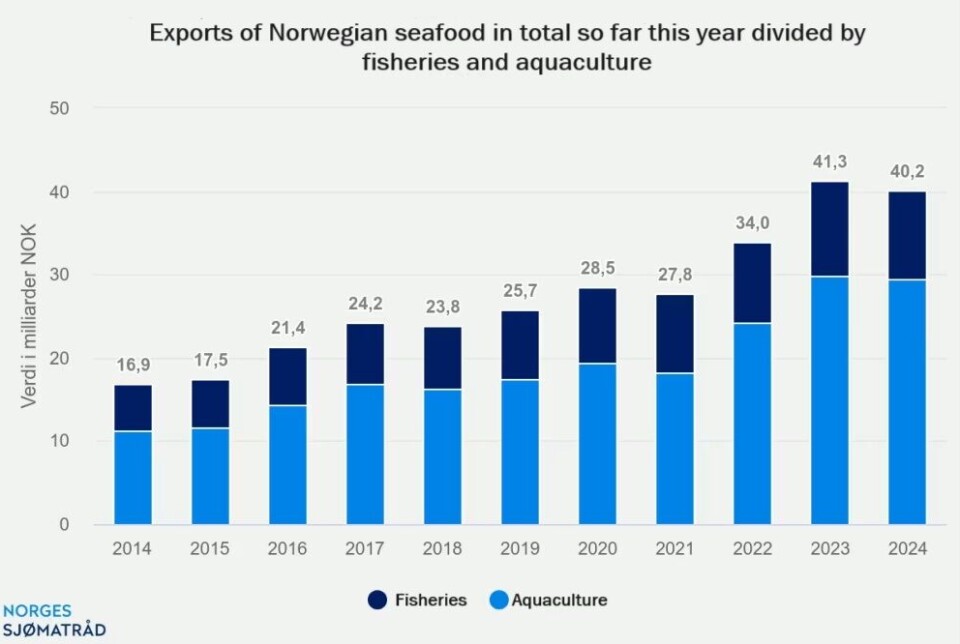
Lower salmon production contributed to drop in Norway’s seafood exports
Three-year run of earnings increases ended in Q1
A drop in the volume of farmed salmon sold abroad contributed significantly to a decline in Norway’s seafood export earnings in the first quarter of this year.
Norway exported seafood worth NOK 40.2 billion (£2.97 bn at today’s exchange rate) in Q1, a decrease of NOK 1.2bn, or 3%, compared with the same period last year. The drop follows three years of consecutive increases.
“Thanks to a weak Norwegian krone and high prices, export value grew in January and February. However, the currency effect declined in March, while there has been a drop in volume for several species in the first three months of the year. The result was an overall decline in the value of seafood exports in the first quarter,” said Christian Chramer, chief executive of the Norwegian Seafood Council.
Norway exported 246,560 tonnes of salmon worth NOK 27.9bn in Q1.
The value fell by NOK 709m, or 2%, compared to the first quarter last year, and volume fell by 6%.
Poland, France, and Denmark were the largest markets for salmon in the first quarter.

“The fall in value for salmon is primarily due to reduced production and lower harvest volumes. This is partly due to lower sea temperatures compared with the same period last year. Increased exports of fillets at the expense of whole fish also contributed to the fall in volume,” said Paul Aandahl, seafood analyst at the Norwegian Seafood Council.
Salmon exports to Sweden received a boost in terms of value in the first quarter. The increase is particularly strong for frozen fillets.
“We see that Swedish consumers are eating more salmon again, and the trend is positive. Above all, they are buying more frozen salmon for home consumption. This is gratifying and is probably primarily because many people want to eat healthier,” said Charlotte Rapp, the Seafood Council’s country manager for Sweden.
Denmark
Denmark saw the largest value growth in the first quarter, with an increase in export value of NOK 142m, or 7%, compared with Q1 2023.
The export volume to Denmark was 24,022 tonnes, 8% higher than in the first quarter last year.
Norway exported 81,900 tonnes of salmon worth NOK 9.3bn in March – a fall of NOK 1.8bn (16%) in value and 12% in volume compared to March last year.
Trout
Norway exported 13,942 tonnes of trout worth NOK 1.4bn in the first quarter.
The volume increased by 39% and value by NOK 273m (25%), compared to the first quarter last year.
Ukraine, the United States, and Thailand were the largest in Q1.
“Increased focus on trout has resulted in growth in production volume and export volume in the first three months of the year. While there was growth for fresh fillets for salmon, it is fresh whole fish that is increasing within the trout category,” said Paul Aandahl.
Cod
Exports of fresh farmed cod increased by 6% in volume, or 180 tonnes, to a total of 3,250 tonnes. Export value increased by 23%, to NOK 180m, against a background of lower landings of wild-caught cod due to quota reductions. Exports of fresh cod fell by 19% to 18,454 tonnes.
"We have to go back to 2012 to find a lower export volume of fresh wild cod in a first quarter,” says Seafood Council analyst Eivind Hestvik Brækkan.
"In terms of value, farmed cod accounted for 15% of fresh cod exports in the first quarter.”























































